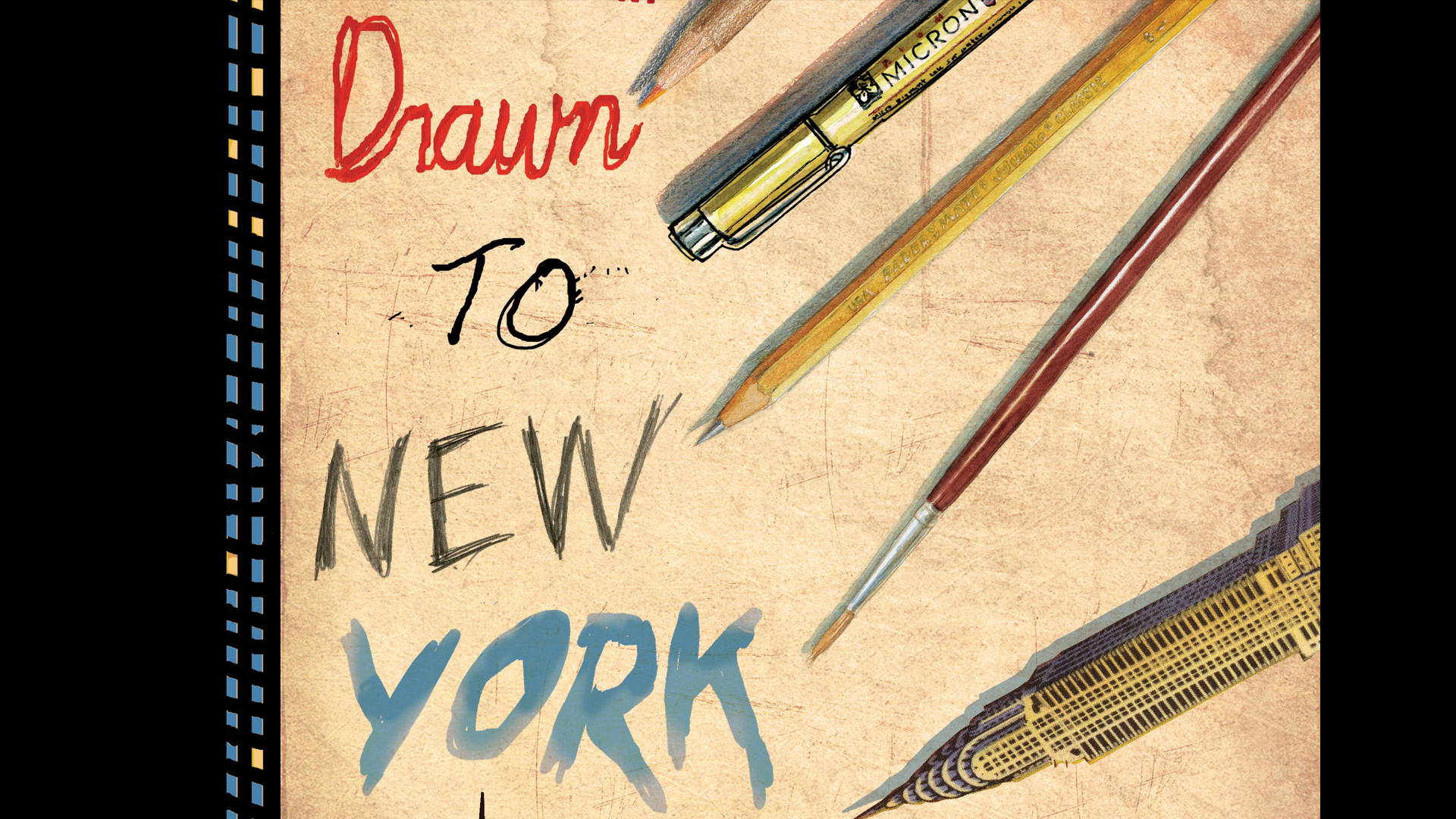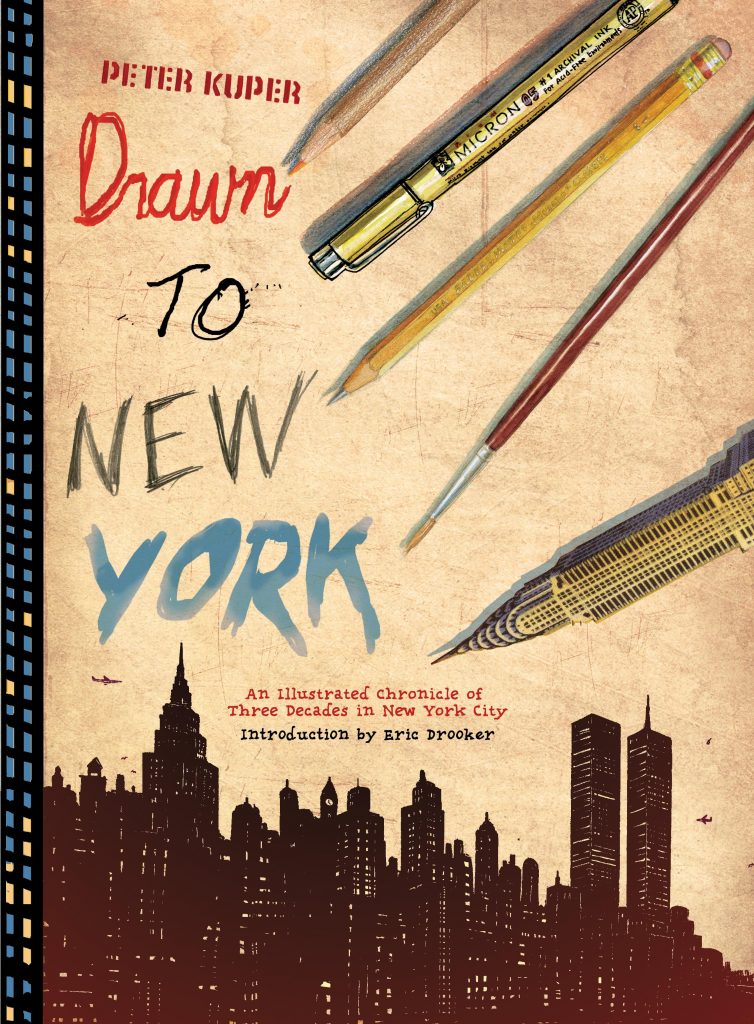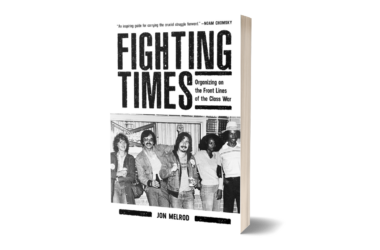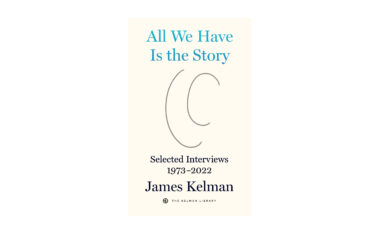The New York Comics & Picture-Story Symposium
May 3rd, 2013
The New York Comics & Picture-Story Symposium is a weekly forum for discussing the tradition and future of text/image work. Open to the public, it meets Monday nights 7-9pm EST in New York City. Presentations vary weekly and include everything from historical topics and technical demonstrations to creators presenting their work. Check out upcoming meetings here.

Peter Kuper came to present a summary of three decades of his work at this week’s symposium. In his bag was a small stash of copies of his soon-to-be released book Drawn to New York, fresh off the press, as well as his usual kit of on-location sketching materials signaling the next book to come.

Kuper began by pointing out that storytelling through comics has always been a significant part of the human experience as evident in the very early cave paintings. The stories that we choose to tell one another are significant preservers of the culture, perhaps more so than anything else. He followed this slide with a stream of images representing generation after generation of visual artists influenced by the city of New York. For as long as there have been people, there has been a desire to leave a mark behind. But this universal desire has been blown to wild proportions in New York mostly because it is so hard to mark.
The city seems to offer endless possibilities and opportunities for artists. There are vast amounts of surfaces to cover, be them walls on the street or in a gallery, sidewalks and subway cars, newspapers, journals, magazines and books, storefronts and benches, posters, flyers, napkins and canvases. But the marketplace dips and rises and the rapid renovation alongside the decay of the city’s infrastructure propels the visual history of the city as an independent meta-structure while its physical origins are erased with a single beat of the urban drum.

For instance, images which began their lives as graffiti embedded onto the concrete itself, have emancipated themselves as icons of the city.

The popular Sunday Funnies characters who reflected the urban daily life of the old tenements have faded along with the crumbling newspapers they were printed on, but have since become coined in the journalistic language. Or the story of MAUS that began as loose pages in Raw Magazine which was sold through the mail and went on to win a Pulitzer Prize and took its place in the pantheon of american literature.

The city constantly calls its artists’ gaze onto itself and inspires obsessive documentation of its daily life, yet it does not promise to sit still long enough for one to feel a familiarity or a citizenship. Kuper explained that it is easy to see how Jack Kirby’s alienated points of view in his earlier illustrations have evolved into the stories of “The Fantastic Four” and other superheroes who remain forever outsiders no matter how many adventures they go through.
Most of the illustrated marks that have long since evaporated from the physical grid, scraped off the post boxes or discarded with the daily paper are forever embedded as the backdrops of the NYC fantasies, legends movies and fiction. They shape not the city itself, but the perception of it and the imagination of the artists to come. It is largely the images themselves which attract artists from outside like moths to the flame that covers their tracks. For an artist striving to survive in New York what is left is to take a place in the imagination and to reflect that of those before him.

So many of those images are apocalyptical scenarios where all that is left to recognize is the city’s famous skyline which lends itself well to destruction and floods.

Kuper talked a lot about the important role of nostalgia while living in a place that seems to contradict the basic conditions for creating a life for oneself. The city never ceases to inspire yet there remains the need to feel one has arrived somewhere where he belongs.

Through the eyes of Winsor McCay’s Little Nemo we may learn about a cityscape that once was, and through the eyes of Ben Katchor’s Julius Knipl, Real Estate Photographer, Kuper finds himself reminiscing about a city which has never existed. The nostalgic emotion provides the crucial emotional connection to the city Kuper has made his home.
Kuper added the best way he has of feeling at home in NYC is to venture away from it and realize how much he genuinely fears being anywhere else. He told us about his most recent out of town vacation. He arrived at La Guardia Airport only to find out all flights had been delayed indefinitely on account of the air traffic control budget cuts. He then canceled his flight and thought of nothing that would make him happier but the sight of Manhattan’s skyline.

Kuper’s personal story began in 1977 when he disembarked a bus from his hometown of Cleveland, Ohio during his first vacation from college. The song playing in his head, which he sang out loud to us, was Frank Sinatra’s classic “New York, New York.”

The city he beheld was dirty, decaying, dangerous and poverty-stricken but he felt he had arrived in heaven.
In the six week intervals between the calls he would make to the head of the animation studio he was promised to work for, he pounded the pavement with his portfolio gravitating towards the siren call of the city’s glamorous architecture.

Ever since, every day has held for him the promise of a thrilling adventure “minus the 20 dollars walking out of the door fee,” Kuper jokes. He flipped through a few spreads of the sketchbook diary he regularly carries around with him and of which excerpts have been published in this new book. The overlaid scenes he records vary in style. The diversity of the moment he observes accommodates his love of experimentation with various mark-making materials. From a multi-colored pencil, collages of ticket stubs and restaurant bills, water colors, stencils to micro-pens and ink brushes.

Throughout his talk, Kuper inserted numerous allusions to the movie industry and described his sincere adoration of cinema. “This is the best movie ever!” he exclaims whenever he catches a movie set in New York on TV. He becomes somewhat excited by what he phrased as “real-estate porn.” Every so often he would watch something like “Rosemary’s Baby” and find himself giddily peering over Satan’s shoulder, as the characters behind him venture into “the next room,” or “turn into a corridor” both quite fantastical situations in a NYC apartment.

Whereas New York has always been one of the main backdrops in the movie industry, the everyday experience of the city is much more similar to comics than film. The city randomly organizes its people into isolated static frames/moments, pausing (or not) at traffic lights, bus-stops, queues. Creating a story means contemplating the mysteries of the tissue connecting them. Asking what might be the element holding together a subway car packed with languages and outfits, and whether it’s strong enough to stop them from disappearing completely from each-others lives as it screeches into a halt is a sequential artist’s question. Kuper demonstrated this with his wordless story “One Dollar” accompanying it with a jazzy tune playing from his iPhone.


Comics is a medium that is a direct reflection of the musicality, the architecture, and the sense of time that may be perceived as both static and dynamic at one glance.

It is clear to see why the city has always been a Mecca of cartooning, but having said that, he refrained, “I consider surviving here in this medium for such a long time an achievement in its own right.”

Another unique aspect of the city Kuper touched upon was the way its architecture challenges the definitions of high and low. The city’s population disappears underground and then resurfaces only to disappear once more to the top of a sky scraper or into the depths of the urban jungle. The skyline dips and ducks, the streets are strewn with gaping holes. Everyone has a different destination but the rhythm is unanimous. Just as they pump the city with a continuous stream of traffic, the visual chronicles of the city all merge into a single musical continuum. Throughout art history, the terminology for artforms that have crossed over set lines has often been deprecative. Such is the term “Ashcan School” for artists who turned to document the underbelly of the city life, or the term “Graphic Novels” describing the literary works of Lynd Ward and Will Eisner. However, the contrast and resistance are authentic to the nature of the city. Kuper said he based the design of his book on this notion of blurring the lines. As a visual artist he derives inspiration from the worlds of comics, illustrations and fine art alike. Thus, he laid out his paintings besides sketches, and gag cartoons beside introspective portraits. Kuper said he also deliberately mixed the chronology of his work to emphasize his thesis that an artistic quest has nothing to do with definitions. Just as every stroll around the block challenges the containing, permanent quality of architecture simply by introducing a new point of view to the continuum.
Kuper admitted that while the sustained notion of discovery may numb any visions of terror or overwhelming sadness with a false sense of satisfaction, they also mean he never stops seeing. This is his way of paying tribute to the homeless, the impoverished, and the isolated.

After the events of 9/11 he wished art could do more, ultimately realizing that “creation in the face of destruction was of the utmost value.” In this context Kuper mentioned the importance of political publications such as WW3 as a vehicle of streaming confrontational images into the media which would otherwise remain outside the visual landscape.

Kuper explained his choice of recent years to take on long-term projects and cut back on editorial illustration jobs. He said his political illustrations had a greater relevance during the Bush administration when mainstream magazines like Time were willing to publish more political and angst-driven illustrations. However, now there seems to be an editorial attitude that strong political images are less important and can be toned down, as if now “everything is fixed.”
***
Image 1:Peter Kuper, Drawn to New York, PM Press 2013
Image 2: Banksy, 2005
Image 3: portait of Keith Haring
Image 4: Richard F. Outcault, Merry Xmas Morning in Hogan’s Alley, 1895
Image 5-6: Peter Kuper, Drawn to New York, PM Press 2013
Image 7: Eric Drooker, Flood, Dark Horse Books, 1992
Image 8: Winsor McCay, Little Nemo In Slumberland
Image 9-16: Peter Kuper, Drawn to New York, PM Press 2013
Image 17: George Belows, Cliff Dwellers, 1913
Image 18-19: Peter Kuper, Drawn to New York, PM Press 2013
***
About the author: Keren Katz has a tattoo of a helicopter by Peter Kuper above her right knee. She is the illustrating half of The Katz Sisters duo and also the half that is not fictitious. Her latest graphic novel “The Night Poetry Class in Room 1001” debuted in April. Check out more her projects here, and more of her books here.






